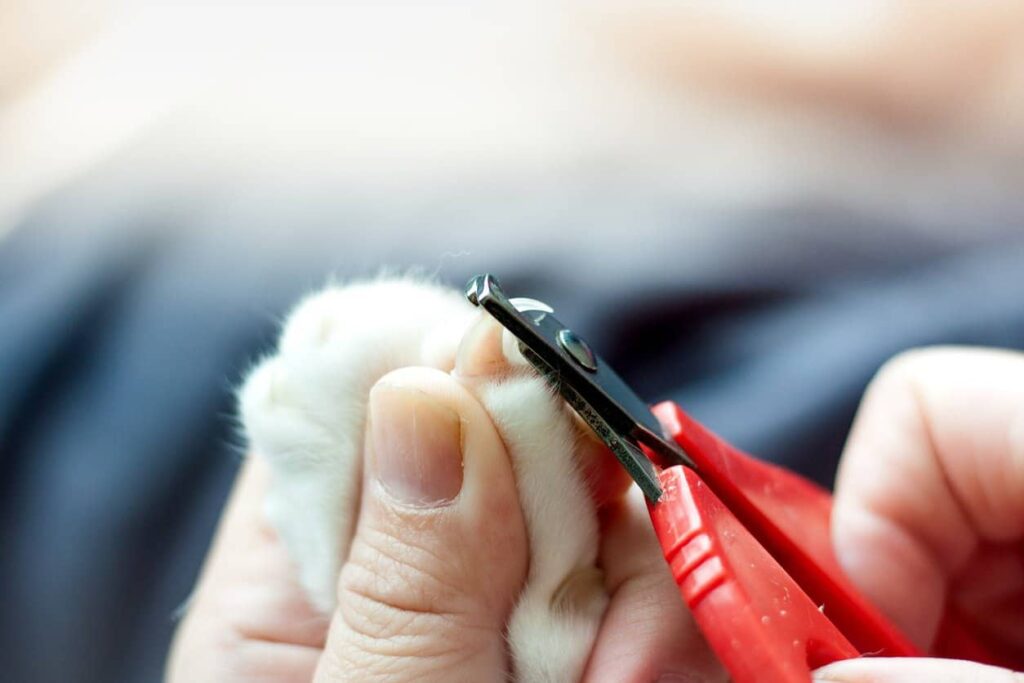You might be wondering what is the best way to restrain a cat to trim its nails so that you don’t get scratched or your cat hurt. It’s basically listening to your cat, dog, or any other pet that needs its claws cut on a regular basis. The First key is really reading social cues just like you would if you were having a conversation with a person.
Animals are communicating with us in every interaction we have with them. When you are speaking with a person, ideally there is an appropriate exchange of sharing thoughts, ideas, and responses. Typically we sit or stand at an acceptable distance from one another to communicate. Then there is some form of acknowledgment that we have actually heard what the other person has said and we comment or respond. It’s the same way with animals.
Just because an animal’s language is different than people’s, it is by no means any less important. The Second key is patience. I’m going to repeat . . . . yes, the word . . . .
P a t i e n c e
Handle Paws Frequently
This is where most pet’s people fall short. Probably the single greatest factor in acquiring any animal’s co-operation is patience. If we just wait for them to process what it is we are asking of them, such as trimming nails we’ll make great progress. The end result is we won’t have to restrain them at all! Just listen to them and dance with them, do not try to ‘DO’ anything to them, but work together as team.
The Third key is to start handling their paws as frequently as possible when you are NOT trying to clip nails. If your cat is the cuddly type, use the opportunity when you are stroking them be sure to run your hands all the way down their legs gently touching those front paws and the pads underneath and holding them for a brief second.
Basics: Clipping Cat Nails Effectively

Most importantly, begin to handle your cat or kittens paws as frequently as possible. You can do this while picking them up and holding them or when they are enjoying cuddle time and being stroked. Learn to pet not only their backs but down all their legs (front & back) landing at the paws and holding briefly. Many times they will resist, but after a while, if you persist in your gentleness and consistency they will realize there is nothing to fear and will eventually come to enjoy it.
I personally give my cats little massages between their toes and have since we adopted them completely feral at 3 months of age. Cat nail trims were not an option from day one but within a few months we did one whole paw at a time and now two years later they will allow me to trim all their nails practically while they are napping.
Use Just Enough Pressure and Nothing More
The Fourth key is to use just enough pressure to do the job and nothing more. Cats that are adopted, that have had any abuse, or have been feral for any length of time, take time to develop trust. Although from the positive intentions of rescues, animal clinics, and fostering, cats and kittens have often been captured and handled roughly. In light of spaying, neutering, vaccinations and loud metal cages these little four-leggeds develop apprehension about being handled at all. So handling them as gently as possible with leadership is a great recipe for success.
First of all, pick a time when they are relaxed or in a good mood. Maybe after eating a meal or playtime. Hold them gently and their paw as gently as possible without any extra pressure, only enough to let them know what you want. For example, with a significantly stressed cat, ask to do only ONE nail at a time and then reward them with verbal praise, petting, and a treat.
If while trying to trim a nail they start hissing, pin their ears, try to scratch you or try to flee abruptly from your arms . . . . finish the one claw and let them know they are Okay. The timing of the reward is imperative. Don’t give them the release until they are calm. It may be a moment or two. Then reward. Divert them with Play. Make it fun. You might just stop there for the day and build on the trust you developed. Wait a week or so and proceed again.
Reward Good Behavior Not Bad

This is a tricky one. The Fifth key is that you want to reward good behavior and this teaches your pet directly what you want and what you are asking of them. On the other hand, you don’t want to reward bad behavior by petting, them, letting them go too soon, or giving a treat right after they try to bite you, scratch you, or flee from your arms. If you give them a treat right after they bite you, essentially you are telling them, “I’ll praise you for biting me”!!
When you get even the smallest amount of submission or co-operation, that is the time to give them the release; that is physically setting them down, telling them ‘good boy or good girl’ and sometimes giving a treat to let them know in their language this is good, this is what I want. Animals inherently want to please their people and thoroughly enjoy being in a relationship with us.
Avoid Clipping the Quick of the Nail
When kitties have translucent nails it’s much easier to visibly see the quick compared to kitties with black nails. Even with my cats who both have translucent nails, I error on the side of caution and usually as a rule of thumb clip only about a total of a quarter of the nail. I do need to trim their nails more often. But since ‘trust’ has been established and it took a little bit to get here, I’d rather have happy, trusting kitties that get their nails trimmed more frequently. For felines with black nails adhering to clipping only the quarter of the nail should prove safe for preventing clipping the quick. Quick Blood Stopper Antiseptic Styptic Powder
Important Considerations

One side note, try to avoid using big bulky gloves on your hands to do nail trimming on your cat’s nail. This can really freak out your kitten or any cat. It gives them one more thing to be afraid of and really is unnecessary if you take the time to build trust.
Rear Paw
As a cat owner, both my cats are indoor cats and I only trim the front nails. I leave the rear paw alone. Not because I don’t think they wouldn’t let me clip them but because for an indoor cat, really only the front paws need to be clipped. Whether you have an indoor cat or an outdoor cat, grooming just the front should be adequate. In particular though, if you have an outdoor cat it is definitely best to leave the back claws intact. This can protect them and help them climb if necessary away from a predator.
The Dew Claw
Also, don’t forget to clip what is called the dewclaw. It’s actually higher up on the leg from the rest of the pet’s nails. The dewclaw can grow long and become an ingrown nail. This is mostly in an older cat. But the younger ones, especially an indoor cat can get hung up easily on the dewclaw.
Additional Tips for Successful Nail Clipping
The KItty Burrito Method ~ You wrap your kitty snuggly but comfortably in a towel or blanket and only pull out the paw you are going clip keeping the body wrapped as to avoid getting scratched.
Flower Essence ~ Rescue Remedy Given a 1/2 hour before the clipping session can help calm down your Kitty, reducing anxiety and apprehension.
Homeopathic Remedies ~ There are numerous homeopathic remedies that can be helpful for anxiety as well. Such as Gelesium and Arsenicum Album. This takes a little experimenting to find the right remedy. And some research to find the best description of the remedy that describes your pet. But once you do the right remedy can work wonders.
Quick Blood Stopper – antiseptic styptic powder ~ Good to have on hand just in case you accidentally hit the quick.
Nail Clippers ~ quality cat nail clippers. Get that nail the first time . . . you can also use human nail clippers. They are very quiet and don’t make any sound which is a huge bonus. The only disadvantage is that it’s harder to see how much of the nail you actually have compared to the cat nail clippers. I have used these many times as well on our kitties. I just have to make sure I have really good light and maybe even have my reading glasses on!
Your Cat’s Diet is Foundational
You might be wondering, how IS diet related to giving your cat the perfect nail trim? When pets are given the proper nutrition for their species it makes all the difference in the world in their health, temperament, disposition, and mood. Since this post is specifically about our feline friends let’s talk about the feline diet. Cats are 90% carnivorous. That means they are obligate meat-eaters.
I have found from my experience with my own cats and those that I have worked with within my holistic animal practice, that cats literally THRIVE on a quality raw food diet. Many health conditions can be healed simply from a raw cat food diet. This is my favorite raw pet food company and what we use right in our own house. I used to grind up whole chickens and add some nutrients to make my own raw cat food.
That is until I found this wonderful raw pet food company. Elijah and Isaiah, our two beloved kitties agree . . . . . they LOVE their food. And yes we pay for quality food for them but it is so worth it to have happy healthy cats. And lastly, it saves me Sooooo much time.
One last note on the diet, they make incredible raw food treats as well, Elijah and Isaiah’s favorite being Lamb Lungs. I noticed the very first time I gave them treats they were so calm. I truly thought it was by coincidence but it happens every time. They are getting the nutrients as if they were eating in the wild. That is what makes a species-specific diet.
ReCap ~ Summary
- Gently start handling your cat’s paws frequently at cuddle time or playtime
- Approach from kindness and gentleness not “doing a procedure”
- Stop! If hissing or aggression (but do not let them go)
- Clip one nail at a time and build on that
- Reward after accomplishing the goal even if after just one claw
- Diversion – make it a great experience and something to look forward to
- Build Relationship and hold your cat rather than “restraining”
- Use Calming products
- And most of all have P A T I E N C E








